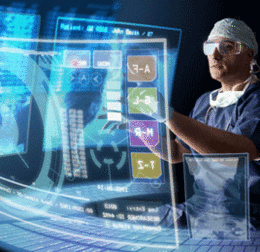
The field of medicine has made enormous leaps and bounds in recent years—and much of it is happening right here.
In recent years there has been an explosion of advancement in the medical field. New innovations and technologies are helping us lead longer and better quality lives. But these advances aren’t happening in faraway places. They’re happening right in our own backyard. Here in South Jersey, much of this new technology is already being pioneered by top docs across various specialties.
“Super advanced technology that seemed as though it was only for a distant future is actually here now,” says James Metz, MD, clinical director, department of radiation oncology within the University of Pennsylvania Health System. “At Penn we’re doing proton therapy, which is a different way of delivering radiation. It was something that might have once been thought of as Star Wars technology, but it’s already in use.”
Docs from several different fields are all saying the same thing. The future is now. We’ve rounded up some of these exciting advances that are taking place right here in our region.
Cancer Treatment: Proton Therapy
Of the many new advances in the field, proton therapy for radiation treatment has been a standout. With conventional radiation, the X-ray goes in on one side and out the other, while radiating everything in between, explains Metz. But with proton therapy, it goes in the body at a lower dose, releases all its energy, and then stops. Nothing goes beyond the tumor.
“That allows us to deliver radiation with a lot less side effects,” Metz says. “We can give potentially higher doses with the potential for better tumor control. More importantly, it also allows us to combine radiation with other agents like chemotherapy which were just too toxic before. The ability to combine therapies is giving us better outcomes.
“We’re also able to treat things we weren’t able to treat before such as the recurrence of cancer. In the past, patients were told if they already had radiation they couldn’t handle having it again, but with proton therapy we can treat those patients. It’s really changing the field of cancer treatment.”
Radiation Oncology: IMRT & Beyond
Other radiation therapies and cancer treatments have also seen huge advances. Radiation therapy in general has changed dramatically. “Modern radiation involves something called IMRT, short for intensity-modulated radiation therapy,” says David Horvick, MD, radiation oncologist with 21st Century Oncology. “With IMRT you use lots of very tiny radiation beams directed at the tumor from multiple directions so that the tumor gets full and high-dose radiation while the surrounding tissue gets low dose. It’s been proven to have a better cure rate and lower side effects than other treatments.”
Cancer Detection: Lung Screening
In lung cancer, 85 percent of cases are diagnosed at stage 3 or 4, when it’s typically impossible to perform surgery. Therefore, only 15 percent of lung cancer cases diagnosed today are cancers that doctors can actually resect and cure. Virtua is looking to change those bleak statistics. With the establishment of a lung navigation program that screens for nodules, they’re detecting cancer earlier and making treatment a viable option.
“Through our lung cancer screening program we’re looking for small nodules in individuals aged 55 to 80 who have smoked for at least 20 years,” explains Eric Sztejman, MD, of Virtua Garden State Pulmonary Associates. “If we do find these nodules we can biopsy early. That allows us to diagnose lung cancer at an earlier stage with a better attempt to cure the individual.”
If nodules are discovered, Virtua also has the latest technology to take the next step. The superDimension Navigation System which utilizes “LungGPS” technology allows doctors to obtain a tissue sample without the same risks posed by conventional biopsy.
Surgical Advances: Robotics
With a movement toward minimally invasive procedures, these days even some of the biggest operations are now done with minimal cutting and, as a result, shortened hospital stays. One of the technological advances driving that trend has been robotic surgery. Roy Sandau, DO, FACOS, of Advocare Associates in General Surgery, and part of the Kennedy Health System, recently performed New Jersey’s first da Vinci robotic surgery with Stapler technology which enhances surgical capabilities and serves as an alternative to many traditional, open surgeries as well as conventional laparoscopic procedures.
“Robotics allows us to push the limits of laparoscopic, minimally invasive surgery,” says Sandau. “You can now perform a large operation with the smallest amount of cutting. In addition, it brings better technology to conventional surgery because it provides 3D visualization. And because the robotic instruments are wristed like a human wrist, I actually have better dexterity when manipulating tissues, blood vessels and organs.”
Fertility Advances: Genetic Screening
Reproductive Medicine Associates of New Jersey (RMANJ) has been pioneering the way in the field, helping hopeful parents from New Jersey and around the world. With advances in Single Embryo Transfer (SET), combined with a well-validated embryo selection method called SelectCCS, RMANJ has found both a safer and more effective way to treat infertility.
“To increase the chances of a successful pregnancy, doctors have transferred more than one embryo in the past,” explains Thomas A. Molinaro, MD, MSCE, FACOG. “But that obviously increases the chance of multiples, which is a complicated pregnancy. Now, because of these advances in genetic screening, we are able to confidently transfer just a single embryo with a much greater success rate.”
With SelectCCS, doctors are actually able to “look inside” an embryo and perform a 24-chromosome screening process. Current data suggests that 50 to 70 percent of miscarriages are due to embryos with too few or too many chromosomes, but SelectCCS allows doctors to only use embryos that contain the correct number.
Chiropractic Advances: DTS
Almost everyone experiences back pain at some point in their life, but for some it’s never ending. Michael J. O’Keefe, DC, DAAPM, of O’Keefe Chiropractic Center, says that DTS Spinal decompression therapy is a new and innovative technique that many might not even associate with typical chiropractic care. With this non-surgical treatment, a computer-controlled traction device is programmed to deliver a gentle stretching force to the spinal vertebra. Most patients report simply feeling a subtle and gentle stretching at their lower back or around their hips.
“By creating this negative pressure, it allows us to actually pull a disc back into its proper position,” O’Keefe explains. “It has been a very effective technique in treating patients and prevents them from considering surgery as an option.”
O’Keefe says that this cutting-edge solution was developed by biomedical engineers, who created the instrument and put it through a series of trials and studies to ensure it worked. Now it’s helping patients with disc problems from degeneration or herniation. “It’s really changing the field,” O’Keefe says. “Patients are getting relief without surgery or spinal injections.”
Chiropractic Advances: Atlas Orthogonal
Though he spent more than a decade performing “traditional adjustments” in his chiropractic practice, Dr. John Sandoz has always been one to remain on the cutting edge of the latest technology. Today the practice has two out of 200 chiropractors from around the world who use “sound wave adjusting” on the upper cervical spine as well as one out of 20 chiropractors in the country utilizing Muscle Robotic Therapy.
The Atlas Orthogonal Percussion Adjusting Instrument has been featured on the hit show The Doctors as well as The Montel Williams Show when Montell Williams himself underwent treatment for ongoing pain. The Atlas instrument gently realigns the atlas vertebrae and can make a dramatic difference—sometimes even in the first visit. “I’ve been on both sides of the chiropractic equation,” Sandoz says. “I’ve done traditional adjustments and I’ve used this new technology. I can tell you that both work. But this works much quicker. In the past my treatment plans were quite extensive. Now we ask patients to give us 10 to 12 visits. Some feel a change after just one.”
Published (and copyrighted) in South Jersey Magazine, Volume 11, Issue 4 July, 2014).
For more info on South Jersey Magazine, click here.
To subscribe to South Jersey Magazine, click here.
To advertise in South Jersey Magazine, click here.












